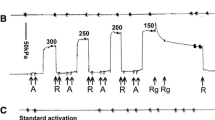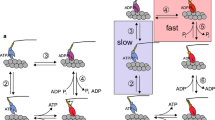Abstract
Possible interactions between the effects of pH and phosphate (Pi) on the maximum force development of cardiac myofibrils were investigated in rat skinned trabeculae in solutions of different pH (7.4-6.2) and [Pi] (where [ ] denote concentration). At pH 7.0 there was an inverse linear relationship between force and log [Pi] over the [Pi] range 0.2–20 mM; its slope (−0.46/decade) was twice that found previously for skeletal muscle [21]. Acidosis depressed force substantially, but the relative change of force was unaffected by Pi addition (0, 5, 20 mM); there was no evidence for the synergism between acidosis and Pi that would be expected if some of the inhibition by acidosis was due to protonation of Pi to the putative inhibitory form, H2PO −4 . It was taken into account that even without Pi addition, there was enough Pi inside the muscle from various sources to produce significant changes in [H2PO −4 ] as the pH was varied. The results suggest that H+ and Pi inhibit maximum force development of cardiac myofibrils independently, by different mechanisms. From this it is argued that H+ and Pi may be released at different steps in the crossbridge cycle. In the myocardium Pi and H+ probably exert tonic inhibitory influences on cardiac myofibrils under all conditions.
Similar content being viewed by others
References
Alberty RA (1968) Effect of pH and metal ion concentration on the equilibrium hydrolysis of adenosine triphosphate to adenosine diphosphate. J Biol Chem 243:1337–1343
Allen DG, Orchard CH (1987) Myocardial contractile function during ischemia and hypoxia. Circ Res 60:153–168
Bagshaw CR, Trentham DR (1974) The characterization of myosin-product complexes and of product-release steps during the magnesium ion-dependent adenosine triphosphatase reaction. Biochem J 141:331–349
Chase PB, Kushmerick MJ (1988) Effects of pH on contraction of rabbit fast and slow skeletal muscle fibers. Biophys J 53:935–946
Chock SP (1979) The mechanism of the skeletal muscle myosin ATP-ase. J Biol Chem 254:3244–3248
Eisner DA, Elliott AC, Smith GL (1987) The contribution of intra-cellular acidosis to the decline of developed pressure in ferret hearts exposed to cyanide. J Physiol (Lond) 391:99–108
Fabiato A, Fabiato F (1978) Effects of pH on the myofilaments and the sarcoplasmic reticulum of skinned cells from cardiac and skeletal muscles. J Physiol (Lond) 276:233–255
Godt RE, Kentish JC (1989) Effect of pH on isometric force, MgATPase, and tension-cost of skinned skeletal muscle fibres of the rabbit and cardiac muscles from rat. J Physiol (Lond) 418:68P
Godt RE, Nosek TM (1989) Changes of intracellular milieu with fatigue or hypoxia depress contraction of skinned rabbit skeletal and cardiac muscle. J Physiol (Lond) 412:155–180
Herzig JW, Rüegg JC (1977) Myocardial cross-bridge activity and its regulation by Ca++, phosphate and stretch. Myocardial failure. International Boehringer Mannheim Symposium. Springer, Berlin Heidelberg New York, pp 41–51
Kentish JC (1986) The effects of inorganic phosphate and creatine phosphate on force production in skinned muscles from rat ventricle. J Physiol (Lond) 370:585–604
Kentish JC (1987) The inhibitory actions of acidosis and inorganic phosphate on the Ca2+-regulated force production of rat cardiac myofibrils. J Physiol (Lond) 390:59P
Kentish JC, Palmer S (1989) Effect of pH on force and stiffness in skinned muscles from rat and guinea-pig ventricle and from rabbit psoas muscle. J Physiol (Lond) 410:67P
Lanzetta PA, Alvarez LJ, Reinach PS, Candia OA (1979) An improved assay for nanomole amounts of inorganic phosphate. Anal Biochem 100:95–97
Martell AE, Smith RM (1974) Critical stability constants. Plenum, London
Mekhfi H, Venturer-Clapier R (1988) Dependence upon high-energy phosphates of the effects of inorganic phosphate on contractile properties in chemically skinned rat cardiac fibers. Pflügers Arch 411:378–385
Metzger JM, Moss RL (1990) Effects on tension and stiffness due to reduced pH in mammalian fast- and slow-twitch skinned skeletal muscle fibres. J Physiol (Lond) 428:737–750
Nosek TM, Fender KY, Godt RE (1987) It is diprotonated inorganic phosphate that depresses force in skinned skeletal muscle fibers. Science 236:191–193
Nosek TM, Leal-Cardoso JH, McLaughlin M, Godt RE (1990) Inhibitory influence of phosphate and arsenate on contraction of skinned skeletal and cardiac muscle. Am J Physiol 259:C933-C939
Orchard CH, Kentish JC (1990) Effects of changes of pH on the contractile function of cardiac muscle. Am J Physiol 258: C967-C981
Pate E, Cooke R (1989) Addition of phosphate to active muscle fibres probes actomyosin states within the powerstroke. Pflügers Arch 414:73–81
Pate E, Cooke R (1989) A model of crossbridge action: the effects of ATP, ADP and Pi. J Muscle Res Cell Motil 10:181–196
Stienen GJM, Roosemalen MCM, Wilson MGA, Elzinga G (1990) Depression of force by phosphate in skinned skeletal muscle fibers of the frog. Am J Physiol 259:C349-C357
Wilkie DR (1986) Muscular fatigue: effect of hydrogen ions and in-organic phosphate. Fed Proc 45:2921–2923
Wilson JR, McCully KK, Mancini DM, Boden B, Chance B (1988) Relationship of muscle fatigue to pH and diprotonated Pi in humans: a 31P-NMR study. J Appl Physiol 64:2333–2339
Author information
Authors and Affiliations
Rights and permissions
About this article
Cite this article
Kentish, J.C. Combined inhibitory actions of acidosis and phosphate on maximum force production in rat skinned cardiac muscle. Pflügers Arch. 419, 310–318 (1991). https://doi.org/10.1007/BF00371112
Received:
Revised:
Accepted:
Issue Date:
DOI: https://doi.org/10.1007/BF00371112




